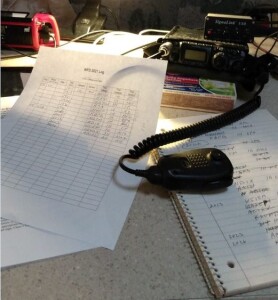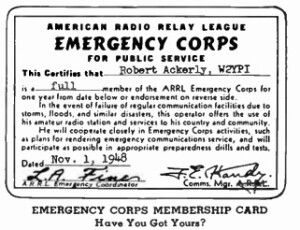 There was a time when electronic communications meant wires running from city to city. In the United States, these were the telephone lines owned by The Phone Company, or telegraph lines owned by Western Union. If those lines were knocked down due to some kind of natural disaster, then whole communities could be cut off from the rest of the world.
There was a time when electronic communications meant wires running from city to city. In the United States, these were the telephone lines owned by The Phone Company, or telegraph lines owned by Western Union. If those lines were knocked down due to some kind of natural disaster, then whole communities could be cut off from the rest of the world.
When that happened, Amateur Radio might serve as the only link. And 75 years ago this month, the June 1948 issue of QST announced that Western Union had reinstated a cooperative program with the ARRL to ensure that hams were available as backup “when wires are down.” It was a reinstatement because Amateur Radio had been off the air during the War, and the program originally dated to 1939, as announced in the June 1939 issue of QST.
The ARRL was able to “give W.U. a list of Emergency Coordinators (EC), so in any pinch, the W.U. local managers will know who to call upon for coordinated information on the active amateur stations, radio schedules, points in radio nets, local emergency-powered outlet, and so on, so
necessary emergency traffic might be filed.” For their part, Amateurs were encouraged to fill out ARRL Form 7 and give it to their EC to sign up as members of the Amateur Emergency Corps. In fact, the blank forms were available at Western Union offices, and could even be dropped off there, with Western Union routing the forms back to ARRL headquarters.
In reports of disasters, it wasn’t uncommon to read that hams had assisted Western Union when the lines were down. For example, during the 1940 Armistice Day Blizzard, Sherm Boen of Albert Lea handled traffic for the railroad, since a dispatcher in southern Minnesota needed permission from Minneapolis before sending a snowplow north.
These days, it’s unlikely (but not totally inconceivable) that the normal telecommunications networks will fail completely. In addition to ground-based lines, there are multiple satellite options available for linking various communities. So it’s unlikely that an internet service provider or phone company will call hams for assistance with restoring their networks.
However, it’s not unheard of for individuals and families in areas hit by disasters to be cut off from the outside world. The ability to send a short message to family or friends in other states could be a major morale booster, and could be extremely helpful in reuniting families separated by disasters. Hams spend an inordinate amount of time trying to find a “served agency” to whom they can offer their services. But radio communications today isn’t exactly rocket science, and those agencies can probably have communications in place operated by their own personnel.
 But hams still have a major strength, and that is the fact that they are widely dispersed around the country, mostly in residential areas. In other words, if there is a local or regional disaster, they are already there, and they can begin communicating immediately. As exercises such as Field Day and Winter Field Day prove, they can be on the air immediately, even if power is out, and even if part of their station is damaged. A wire antenna can be put up almost anywhere, hooked up to an HF rig and car battery, and communications are immediately established. Even the most modest of VHF rigs can provide local communications with other hams.
But hams still have a major strength, and that is the fact that they are widely dispersed around the country, mostly in residential areas. In other words, if there is a local or regional disaster, they are already there, and they can begin communicating immediately. As exercises such as Field Day and Winter Field Day prove, they can be on the air immediately, even if power is out, and even if part of their station is damaged. A wire antenna can be put up almost anywhere, hooked up to an HF rig and car battery, and communications are immediately established. Even the most modest of VHF rigs can provide local communications with other hams.
It seems to me that individual hams should figure out how they can serve their neighbors in time of emergency. In my case, I will simply make it known, perhaps with a sign in the front yard, that I can send short messages to anyone, just about anywhere, via Amateur Radio. I have multiple radios that can be pressed into service, and all I need is some wire to build an antenna. For power, I have multiple options, such as a car battery, flashlight batteries, or a solar panel. I can be on the air almost immediately, and stay on the air more or less indefinitely. I don’t need any agency to serve. My license is the only authorization I need to offer my services to my neighbors.

